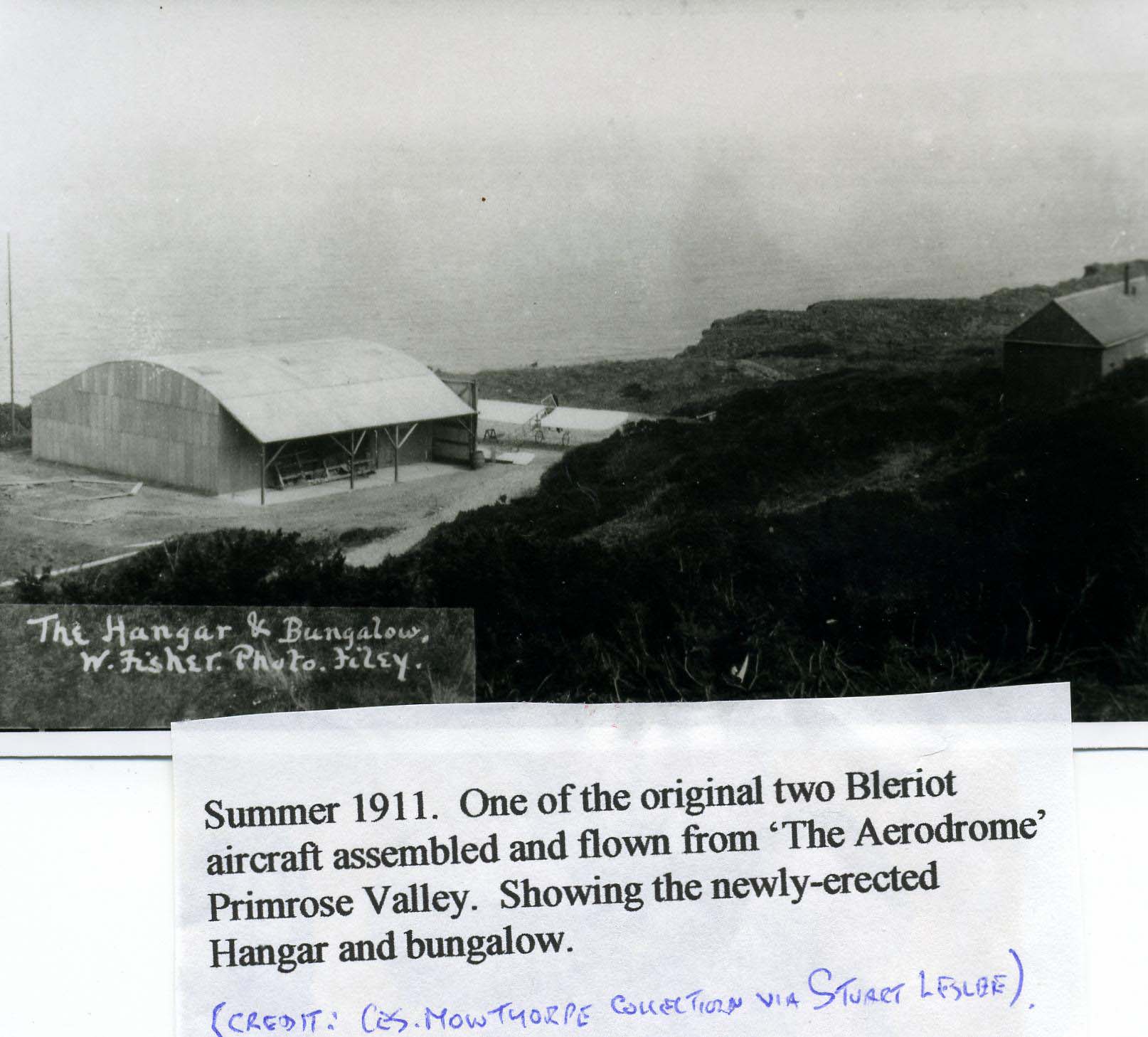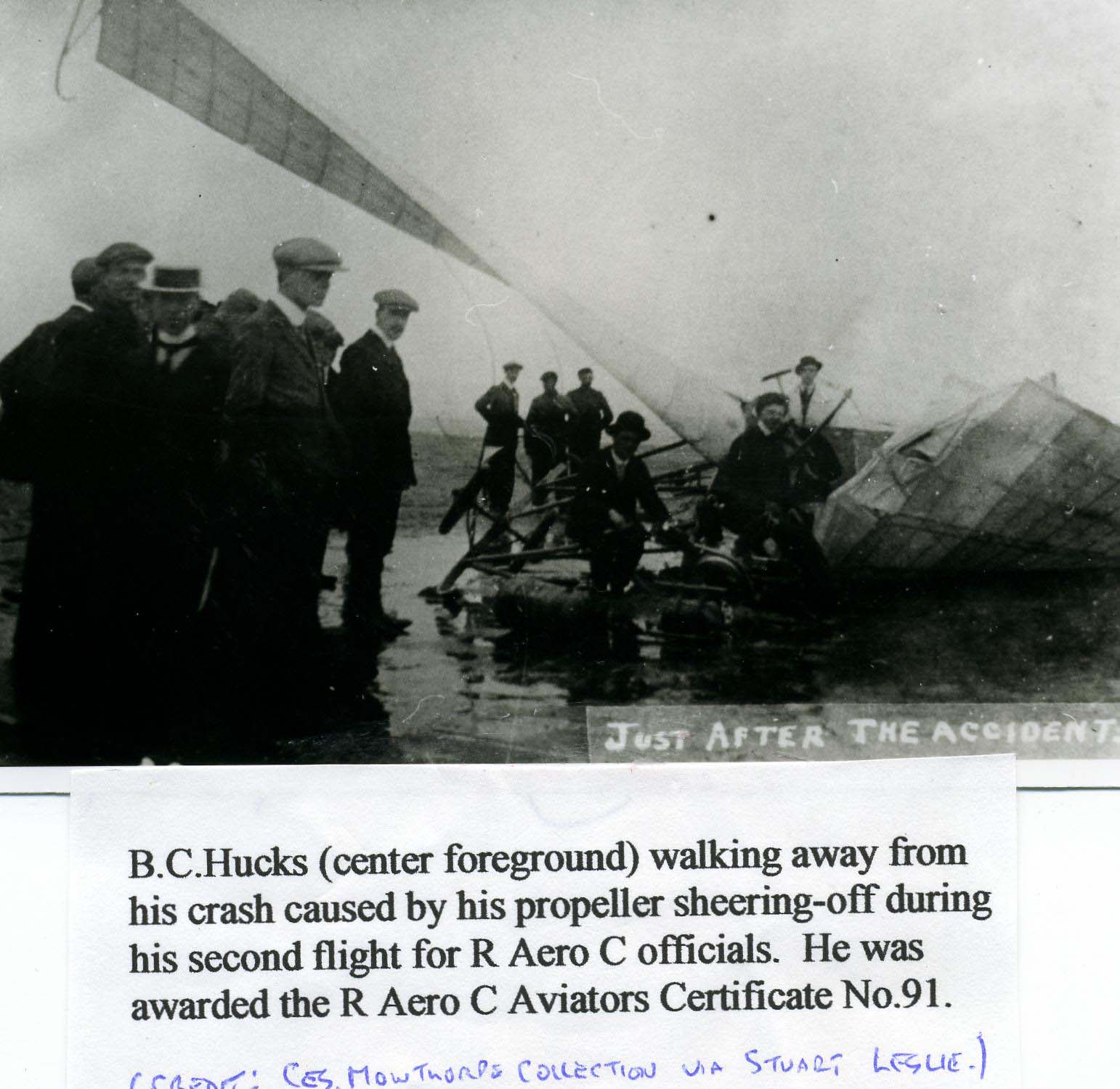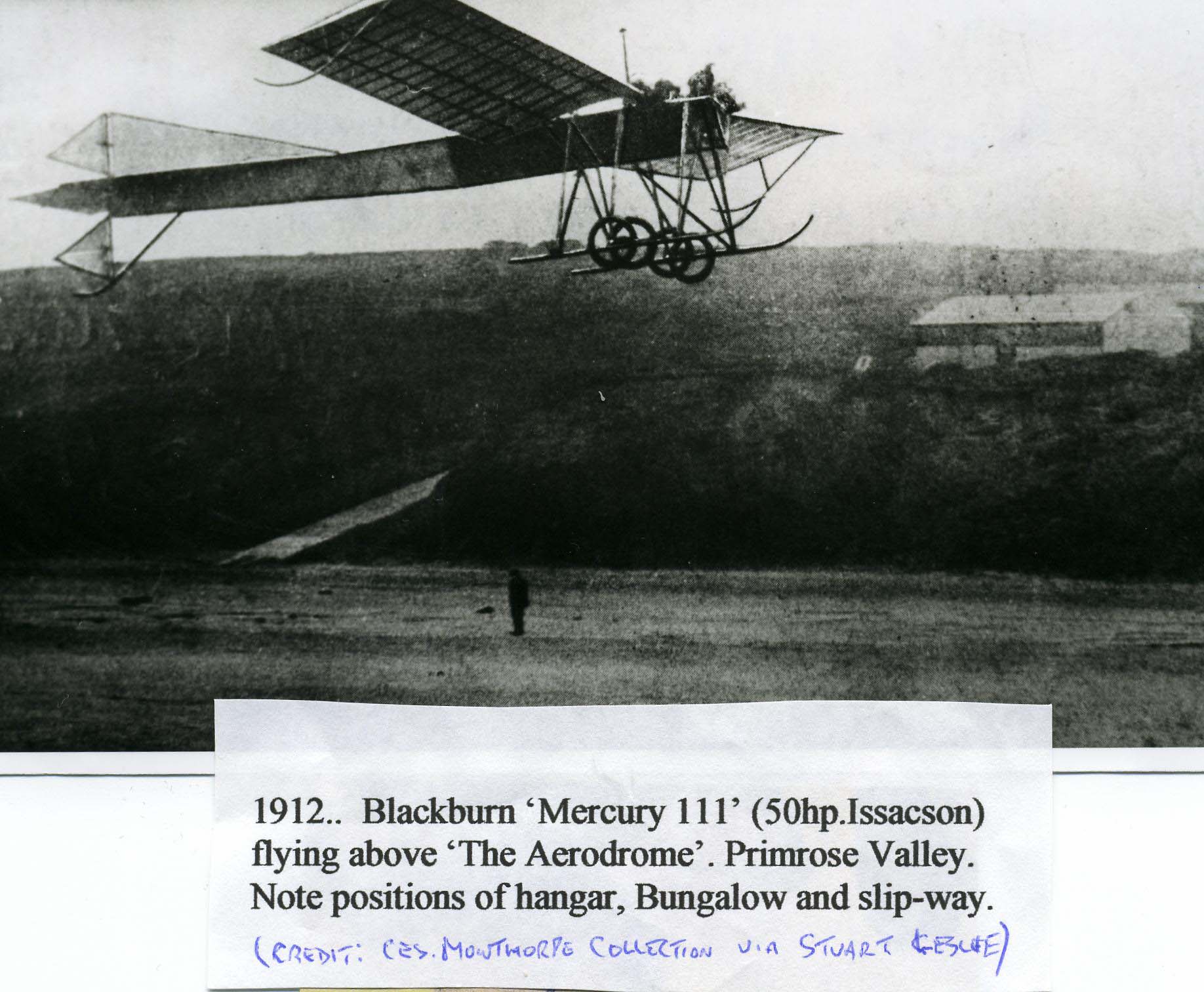FLYING FROM FILEY SANDS
July 1910 – September 1912
By Ces.Mowthorpe. (Copyright 2005)

Few of the visitors that come to Filey Bay each year realize that those golden sands once formed a natural flying-ground for the earliest designs of that great Yorkshire aircraft designer Robert Blackburn OBE; AMICE; FRAeS; MIME. It was at Filey that most of the earliest designs, built in his Leeds workshop, were finally assembled and flown.
Although many people have heard about the Blackburn’s connection with Filey, very few are aware that his was not the only flying that took place on these sands.
April 1910 saw an application made to Filey Urban District Council, asking for permission to use their sands as a base for aircraft to take-off and land. This successful application was made by one J.W.F.Tranmere – a resident of Scarborough. Upon receiving the aforementioned permission, the Northern Aerial Transport Co.Ltd. was formed, operating a ‘flying-school’. Why they applied to Filey is obscure because most of the area used for flying came under the jurisdiction of the Bridlington Rural District Council. Actually all the beach (in1910) belonged to the Lord of the Hunmanby Manor (Ledgwick Mitford Esq. Mitford Castle. Co. Durham) who possessed full Lordship rights). Was he ever consulted ? Certainly the land for the hanger etc. was bought from his Hunmanby estate.
Construction began on a concrete slipway (blown-up by the Army in 1940 as an anti-invasion measure), an aircraft hanger and a bungalow (this bungalow was still in-situ in 2004) . Two Bleriot monoplanes were bought in France and transported over the Channel, then by rail to Filey Station, then loaded onto farm rullies and taken to Primrose Valley where they were re-assembled. Officially opened on 25thJuly 1910, flying commenced. The first pilot was one J.House and he flew the first Bleriot. Little is known now about this early period, specially regarding other members of the Northern Automobile Co.Ltd. or who else piloted the Bleriots but flights were carried out with both aircraft.
The magazine ’FLIGHT’ carried an advertisement on 22nd October 1910 placing the Hangar and bungalow at Primrose Valley ‘for rent’. Robert Blackburn agreed to rent both premises for 10/- (50p) per week each. Blackburn’s reason for renting was to assemble and fly his second design – known as the ‘Light-type Monoplane’ which was virtually complete in his Benson St, Leeds, workshop. Whilst the Bleriots flew from the sands, the ‘Light-Type’ was assembled in the hanger. It was about this time that Blackburn overhauled the Bleriots, one at a time in his Leeds works. The Filey hanger only comfortably held two aircraft so perhaps (?) the absence of a Bleriot enabled the ‘Light-type’ to be assembled there-in ?
About this time (late 1910/early 1911) the up and coming pilot B.C.Hucks comes to Filey. Well-known at Hendon, the seat of British civil aviation and for his flying in America, he was an experienced pilot. However, like most of his contemporaries, he was unlicenced. There was no law stating (at this period) that an aviator required any form of licence to risk his neck !
8th March 1911 was a calm, clear day and Hucks took advantage to test-fly the Blackburn. Taxying for approximately three miles, he gradually eased the aircraft off the sands, flew at about 50ft making a slow left turn. Unfortunately he slipped into the sands and crashed. Unhurt, he walked away and the aircraft was repairable. Repairs were soon effected and henceforth Primrose Valley, Filey became known as The Blackburn School of Flying.

Meanwhile the Blackburn’s next design was nearing completion. This was the ‘Mercury 1’, of which eight were produced in three distinct types. Most made their first flights from Filey sands and the first of these was a two-seater. It was on this machine that Hucks qualified, in front of Aero Club officials at Primrose Valley on 18th May 1911. 17th May, the day previous, Hucks had completed a 19ml flight to Scarborough and back, reaching a height of 1200ft – almost a world record for that time. On the day of his examination, Hucks. after a successful flight was asked to repeat same to clear up a technical point. In doing this, his propellor sheared off and in the subsequent forced landing the aircraft was damaged and Hucks injured. Never-the-less Hucks was awarded his certificate No.91. Soon repaired there were now two Blackburn monoplanes operating from The Blackburn School of Flying. The two Bleriots now disappear from the picture completely although the writer has heard reports of a Bleriot flying ‘in the Dales’ at that period.
Hucks continued as Chief Flying Instructor (CFI) and pupils were taught to fly although Hucks remains the only pilot to obtain his Aero Club Certificate at Filey. He also made a number of notable flights, one being a night-flight from Filey Sands, on to Bridlington, then up to Scarborough and back to Filey, the last ten miles with a failing engine. He landed successfully with the aid of bonfires lit on the beach. August 1911 saw Hucks leave Filey with a new single-seater Blackburn ‘Mercury 2’ in a bid for the Daily Mail £10,000 Circle of Britain Contest. Unfortunately he had to retire early but went on an extended tour of the West Country which was very successful. Although keeping in touch with Blackburn, his employment was severed and his position of CFI at Filey being taken by one Hubert Oxley who commenced his duties on 3rd September 1911. Meanwhile Hucks went on to achieve fame as the first Englishman to perform a loop in an aircraft.

One of Oxley’s first innovations as CFI was to turn the front (passenger) seat of the Mercury 1 (now repaired) around, facing backwards. This was in order that the pupil may visually observe the pilot’s control movements during early flying training. An interesting feature of these early Blackburn monoplanes was the ‘Blackburn Patent Triple Steering Column’. This consisted of a car-style steering wheel, projecting out from the instrument panel which operated the rudder when turned. The elevator was moved up and down (to lift or depress the nose) as was the column. To operate the wing-warping in order to bank the aircraft from side-to-side the column was moved sideways. No pedals being necessary.
A limited amount of ‘joy-riding’ took place at The Aerodrome, Primrose Valley during this period. The first lady passenger in Yorkshire being Miss Cook – a local resident.
The first Blackburn Mercury 111 (a three-seater) took off from the sands on it’s maiden flight on 9thNovember 1911 with Oxley at the controls. Several more flights were made in this machine including another night flight on 27th November 1911. A pupil at the school named Weiss was flying with Oxley in the Mercury 111 on December 6th when immediately prior to landing Oxley lost height in a steep dive (a practice he frequently indulged). Unfortunately on this occasion fabric started to strip off the wings, which then collapsed leaving the fuselage and occupants to crash onto the sands – with fatal results. The remains of Oxley and Weiss were taken into an outbuilding of the ’Three Tuns Hotel’ at Filey pending an inquest and local police impounded any ‘souvenirs’. An inquiry established that the dive had been ‘steeper than normal’ – estimated speed 150mph. Fabric had torn away causing over-stressing, hence breaking-off of the wings. During it’s six-week life the Mercury 111 had been built with a set of parallel wings but these were changed for a new pair of tapered wings (9ft at the roots and 7ft at the tips) prior to the fatal flight. After exhaustive enquiries this factor was eliminated from the cause of the disaster. Oxley had been the only ‘pilot in charge’ (PIC) of the Mercury 111.
Jack Brearley became the next CFI Flying for Blackburn. He occupied this position until after the Blackburn School of Flying moved down to Hendon in September 1912. Several more Mercury 111’s made first flights from Filey Sands including the second Mercury 111 (Issacson engine) and the fourth Merury 111 (Gnome engine) both which were retained as ‘school machines’. Blackburn only moved to Hendon, which was the center of flying in this country, because he hoped to get some military contracts from the appropriate authorities. The |Aerodrome, Primrose Valley proved beyond doubt that Robert Blackburn could design and build practical aeroplanes of excellent quality and must be remembered for this.
Blackburn’s connection with this part of the country did not quite end at Filey. A hangar was built at Scalby Mills, north of Scarborough, to assemble and house the big ‘Blackburn Type’L’ with which Robert Blackburn had designed in conjunction with the 1914 ‘Round Britain Air Race’ the pilot being Sidney Pickles. Arguably, had the First World War not started, both Filey sands and Scalby Mills may have been used by Blackburn in conjunction with each other ? After the outbreak of hostilities the ‘Type L’ remained at Scalby Mills armed with a light machine-gun and carried out a number of patrols along the coast. Finally, flown by R.Ding it struck the top of Speeton cliffs during a ‘sea fret’ en route to RNAS Killingholme and was written-off, fortunately without injuring the pilot. Another occupant of the Scalby Mills hangar was Blakburn Improved Type ‘I’ monoplane. Unsuitable for military, this little monoplane was subsequently fitted with floats and sent to Lake Windemere as a trainer upon which a number of early RNAS pilots received their elementary training.
Meanwhile at Primrose Valley, the old Blackburn hanger was used for storage by the military battalions engaged in coastal defence duties. Circa 1921 the Primrose Valley hangar was purchased by Fredrick Parker. Engineer of Hunmanby who dismantled it with the intention of re-erecting same at his Hunmanby works in order to house his four traction engines and threshing outfits’ However, upon examination Fredrick Parker discovered that there was not enough headroom for his machines and this hangar was ‘sold-on’ to a destination ‘.up North’. In its place, one of the dismantled hangars from RAF Driffield was purchased, re-erected and part remains there today 2005. Inside the Primrose Valley was discovered an unusual little aircraft. Reputed to have been the brainchild of ‘an unknown Frenchman’ who left hurriedly owing rent, it consisted of a small square-sectioned fuselage constructed of Balsa, covered with fabric. The nose was aerofoil section with a large skid running upwards from a wheeled undercarriage. Three different sets of wings were alongside. In the words of Mr Sidney Bright, a Parker employee who was present, the three sets resembled 1) ‘a swallow’s wings’ 2) ‘a gull’s wings’ and 3) ‘ordinary wings’ ! Length was about 15ft and span about 30ft. The tailplane was normal. It was an ornithopter, the wings being operated by vertical rods connected to bicycle pedals. Believed to have been passed onto Hull Museum it probably was destroyed by German bombs in the second World War.
Just as the first aircraft to Fly from Filey Sands, the two Bleriots have been lost to memory, so has the last to be constructed, by designer unknown.